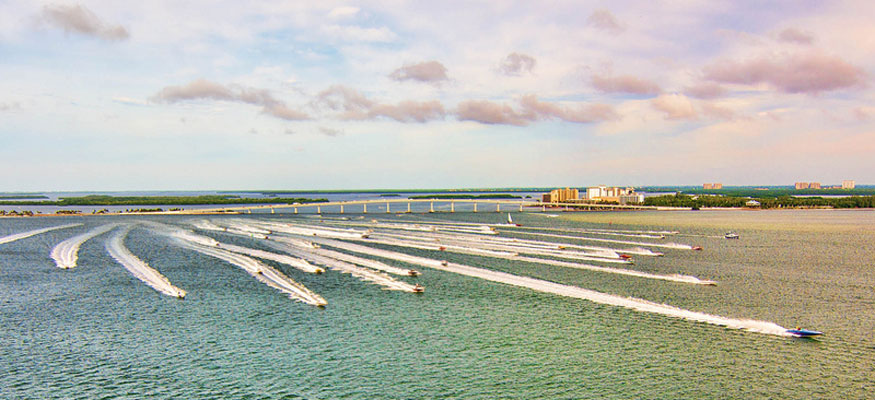Tres Martin’s Safety Corner: Crossing Wakes
Quick quiz: What’s the best thing you can do to make sure you cross the wakes of other performance boats safely and comfortably?
A) Speed up, turn hard and hang on for dear life.
B) Slow down, turn gently and relax.
C) Maintain a safe following distance.
Maintaining a safe following distance is crucial to crossing boat wakes safely. Photo courtesy/copyright Jay Nichols/Naples Image.
While this quiz was designed to be a lighthearted no-brainer, the potential for disaster of attempting to cross the wakes of a boat in front of you if you’re following too closely is serious—especially when such maneuvers are attempted at high speed. That’s the word from top driving instructor Tres Martin, the founder of the Performance Boat School that bears his name.
“When you’re crossing boat wakes, you must have a safe following distance to begin with—that’s essential,” says Martin. “A lot people don’t realize this, but the water immediately behind a boat, because of the way it is being displaced, is higher than it is outside the boat. The boat’s propellers aerate the water, which also makes it higher, and they create a direct thrust current that’s coming right at you and can really upset whatever platform, catamaran or V-bottom, you’re in. The farther back you are, the more forgiving and comfortable crossing boat wakes is going to be.”
As a good rule of thumb, Martin suggests attempting wake crossings while you’re running in a straight line rather than during a turn. Rushing through the process, he says, is a bad idea.
“Get across the first wake and pause between the wake and the thrust line of the boat ahead of you,” Martin explains. “You don’t have to rush. Then cross the other wake and move into clean water again. Your goal is make everyone on board feel safe and comfortable.”
In poker runs and other large-fleet boating events, the numbers of wakes coming at you—and you often have to cross—can be daunting. A little planning and observation can make your life as a driver a lot easier, says Martin.
“A lot of times people will complain about their position relative to other boats on the waterway,” he says. “But you can improve your position with a little planning by trying to forecast where you want to be based on how the drivers around you are operating. Who do you want to be near? Who don’t you want to be near? You can pick up that stuff pretty easily if you pay attention to it.”
Generally speaking, safe following distances when it comes to crossing boat wakes—depending on boat speed, sea conditions and adjacent traffic—are measured in hundreds and even thousands of yards rather than feet. Bottom line: Unless you’re competing in a sanctioned offshore powerboat race, there’s no such thing as “too far behind” the boat ahead of you.
“The loss of control that can happen when you’re following too closely can be really serious,” says Martin. “It’s been a factor in a number of accidents over the years.”
Related Stories


